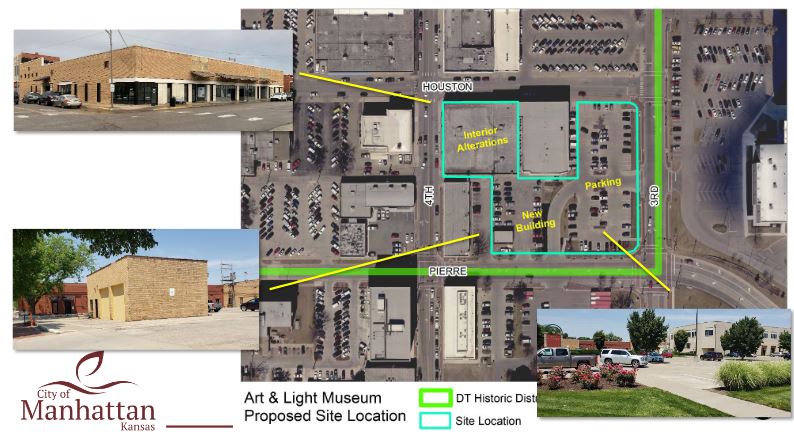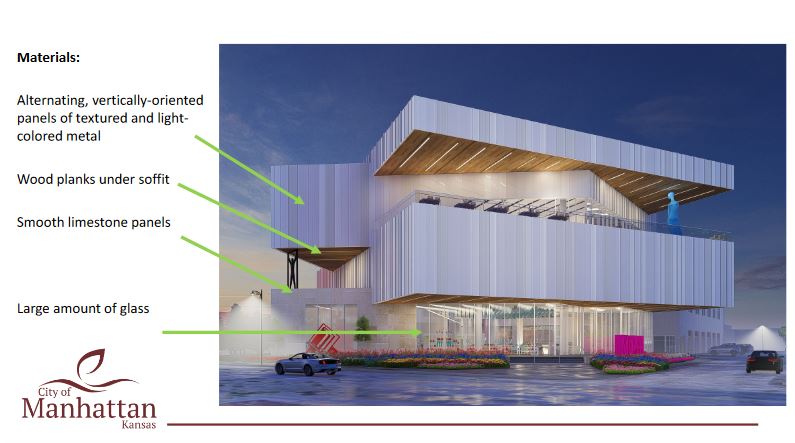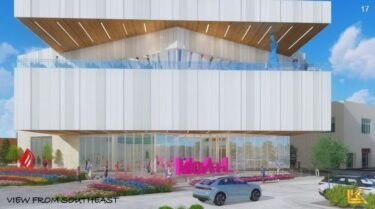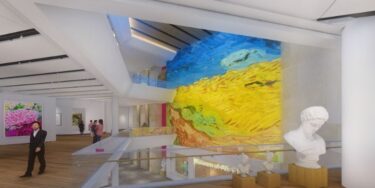

The City of Manhattan looks to April 19 to finalize amended redevelopment plans for the city’s Downtown STAR bond district to account for a private Art and Light Museum proposed to be built at the corner of Pierre and 3rd Street.
Manhattan City Commissioners Tuesday unanimously approved the amended redevelopment plan on first reading as well as overturning the Historic Resources Board’s (HRB) vote to deny the project authorization to move forward.
“We have expected a development on this piece of property, this area, for a long time – for over 20 years,” says Mayor Linda Morse. “It’s finally come and […] I don’t see a feasible or prudent alternative for another 20 years.”
Numerous representatives of the Manhattan/Riley County Preservation Alliance (MRCPA) and an adjacent property owner, though, urged a pause in order for the museum’s developers to reconsider chosen building materials and the planned height of the facility to more align with the Downtown Historic District in which it is planned to be constructed.

Manhattan has been working quickly to get the $43 million development finalized and ready for construction since the museum concept was first floated by the DeBruyn’s, owners of Manhattan’s The Master Teacher off of Seth Child Road near Washington Marlatt Park.
Initially planned and approved to be constructed in the parking lot southeast of the Flint Hills Discovery Center, Robert and Tracey DeBruyn reconsidered the location after 2021 amid opposition due to concerns about parking and potential impact on neighboring property owners. In doing so, they also reduced the proposed size by 10,000 square feet and 10 feet in height.
After the change in venue, the developers have since set their sights on a plot of land at Pierre and 3rd with intent to incorporate existing structures such as the old Sears building into an overall design that would include a 40,000 square foot, 65 foot tall new structure as well. The proposal also includes plans to purchase a city-owned parking lot under lease to the Manhattan Town Center in a three-way agreement between the involved entities.
The relocation prompted the city to begin work entering into 2022 to expand the Downtown STAR bond district by a block in order to encompass the land being eyed for the proposed museum. Doing so opens up the development for an estimated $23 million in sales tax revenue projected to be generated in the district through 2026. Manhattan had received word from Kansas Lt. Gov. and Commerce Sec. David Toland that the project is eligible for the funds if the district were to be expanded.
STAR bonds are a mechanism through which cities can divert largely State shares of sales tax collections from a specified district for a period of time into redevelopment and tourism-generating projects. If Manhattan opts not to expand the district and divert the funds toward an eligible project, the State sales tax dollars slated for the project would return to State coffers. Manhattan will bear no responsibility to repay the STAR bonds associated with the museum project, according to the City Manager’s Office.
“STAR bonds have to play a significant portion of the financing of the project,” says Mark Abbott, counsel for the developer. “It can’t be located somewhere else in the city that is outside this historic area because then it loses out on what allows it to get funded in the first place and get constructed.”
In addition to those funds, the DeBruyn’s will commit an estimated $21 million in private funds to the project as well. Current plans indicate the business will be operated as a private non-profit organization, with city officials stating they have no plans or desire to support the facility monetarily.
In January, commissioners set a public hearing for the district expansion to be held March 1. Following unanimous approval, commissioners then finalized the expansion at a brief meeting on March 15. City administration has noted the tight schedule in order to get the project ready for construction by Fall 2022, placing the now-approved amended redevelopment plan vote on the next possible agenda following the district expansion vote.
In the time between those meetings, the HRB reviewed and rejected the project. The developer opted to appeal the ruling with the city commission, a public hearing for which was placed on the same agenda as the consideration of the amended redevelopment plan.
More work remains before any construction can begin, including approval of the amended redevelopment plan on second reading and a STAR bond sale eyed for the summer. The project could be further delayed if an aggrieved party files suit in court over their decision to overturn the HRB, as permitted by State statute (K.S.A. 75-2724).
Read more on additional details and prior discussion here.
One of the steps required before construction can occur is a review by the HRB given the proposed location of the museum falling within the bounds of the Downtown Historic District. The HRB has authority to review such projects as per agreements between the City of Manhattan and Kansas State Historic Preservation Office under State statute (K.S.A. 75-2724).
The district’s historic character was first recognized in a city ordinance adopted in 1982, officially placed on the National Register of Historic Places in October 2007.
Following a March 28 HRB meeting the board rejected the museum as proposed by 3-2 vote, saying in its decision letter that the board ‘failed to find the proposal to meet the Secretary of the Interior’s Standards for Rehabilitation.’ Specifically, the HRB found the project did not meet Standard 9 and ‘will damage or destroy historic property.’
3. Art and Light HRB Review Notice of Decision
Standard 9 pertains to ‘[n]ew additions, exterior alterations, or related new construction,’ stating that such work ‘shall not destroy historic materials that characterize the property.’
“The new work shall be differentiated from the old and shall be compatible with the massing, size, scale, and architectural features to protect the historic integrity of the property and its environment.”
Size, scale and architectural features were all called into question, with the project featuring smooth limestone, glass and aluminum panels uncommon in the district. The HRB informed the applicant that a modified proposal could be resubmitted for re-review on an expedited process, or they could appeal the ruling with the Manhattan City Commission – which they opted to do.

By state law, city commissioners were required to operate in a quasi-judicial manner in deliberation while hearing the appeal. As such, the commission was obliged to review evidence and weigh whether the project included all possible planning to minimize harm to historic property in question and whether there is a feasible and prudent alternative to the project as proposed.
Feasible and prudent alternative is defined by the state as ‘any alternative solution that can be reasonably accomplished and that is sensible or realistic.’ This can factor in elements such as technical issues, design issues, economic issues, and how a project relates to an approved community plan.
The U.S. Supreme Court has ruled city staff are best suited to analyze and present relevant factors to municipalities, with City Planner Ben Chmiel as HRB staff liaison serving to that effect. This is Chmiel’s second round in such a role in the last six months.
“Height was a major issue cited by the HRB,” says Chmiel. “Compared to buildings within the historic district immediately adjacent, it is relatively tall. The tallest building being 38 feet, the building as proposed is 65 feet.”
Chmiel, though, stated new buildings in and on the edge of historic districts are to act as a transition architecturally or use-wise into different parts of the city. He says there isn’t a lot of context to inform the design on the edge of the district ‘especially when that building is not sharing a facade with any other historic building on that block.’
“Across the street is a parking lot and you have these more modern buildings kind of surrounding it on the exterior of the district.”
The board, though, did not believe the architectural transition was well emphasized or communicated in the design as proposed. MRCPA Treasurer Barbra Poresky spoke during the public hearing, saying the museum would be ‘three times as tall as the adjacent J.J. Marshall building’ and create ‘an abrupt change in height and not a gradual stair step transition.’
Chmiel further broke down his presentation by the various issues open for consideration under the feasible and prudent standard. Economic issues were ‘weighted heavy’ in the consideration, with the project coming in at more than $43 million. Chmiel says that scale of development would ‘dwarf’ an entire year’s worth of industrial and commercial investment in the city in most years.
“This is three times larger than the largest private commercial or industrial development that we have on record,” Chmiel says. “To put it bluntly, this is a very large project unlike anything we’ve seen at the city in recent records.”
Chmiel says the project would be valued higher than the assessed value of the entire Downtown Core, which comes in at $38.8 million. The Manhattan Area Chamber of Commerce has also argued the project will be an economic boon for the community, which was presented for consideration.
“One alternative is to let the site remain or require the project be substantially modified per the HRB’s desires,” Chmiel says. “Modification of this design in terms of its height and materiality in our assessment is of marginal benefit compared to the project coming to fruition.”
Chmiel further pointed to the 2000 Downtown Tomorrow Plan, which indicated a nearby location as an area prime for redevelopment which was further elaborated in 2009 describing a vision of a multiplex movie theater in the area that he says aligns ‘very, very well with the museum as proposed.’
“This museum as a very comparable use is a missing component to that plan.”
Numerous stakeholders presented contrary testimony during the public hearing, including Town Pavilion owner Calvin Emig. Emig attended the March 5 public hearing on the STAR bond district to express concern regarding the museum’s plans to buy a city-owned lot leased to the Mall that is used by his customers and employees.
Emig had previously stated he supports the project, except that the loss of parking would disadvantage the museum’s possible new neighbors. Emig said Tuesday that he doesn’t believe the developer used prudent judgment in their design and that the project should be delayed for a period of time while alternatives are considered.
“This project is substantial, but we’ve also had substantial development in the last 20 years up at the university,” says Emig. “So this is not a once and only project that only comes by, I think that there might be other projects that could be presented for this area and keep it within the guidelines of the Historic Resources Board.”
Poresky further questioned the city staff report using the height of buildings such as the Wareham Hotel, Riley County Courthouse and Flint Hills Discovery Center are compatible with the district’s character while also discounting the importance of using compatible building materials seen around the district.
“So which is it – should the historic buildings on Poyntz Avenue inform the design and material choices of the building or not?” asks Poresky. “It seems Poyntz’s historic buildings should inform the design and materials when convenient – the building’s height in this case – but not when it’s inconvenient such as the choice of more compatible materials.”
MRCPA’s Mel Borst further noted the Downtown Tomorrow Plan cited by city staff does not conflict with the HRB’s concerns, and that the entertainment district proposed in those plans do not encompass the land being eyed for the museum making the visions within it ‘not applicable’ to the proposed museum.
President Linda Glasgow closed contrary testimony from the MRCPA who questioned Manhattan’s rush to push the project through, attributing it to the developer failing to foresee that the HRB might find issues with their proposal.
“Instead a feasible alternative is to pause and request small alterations,” she says. “Which we know are possible because the project was previously paused and redesigned when the location changed.”
Glasgow stated the lifespan of the proposed structure must be taken into account, and that its approval could have a long-lasting impact on the district’s character.
In addition to Chamber and Convention and Visitors Bureau testimony in support of the project, Downtown Manhattan, Inc. Executive Director Gina Snyder says a ‘vast majority’ in the district support the development. She cited additional sales tax, transient guest tax as well as spin-off business to other firms in the district as main reasons from her discussions with members.
“We think that due to the programming and offerings that we already have in Downtown that are art related such as Third Thursdays, our mural corridor now which are eight total murals and two more coming in two weeks, and then the art walks – they all work together,” says Snyder. “This is the perfect culmination of this becoming the art and entertainment district in the City of Manhattan.”
Commissioners ultimately were unanimous in their vote to overturn the HRB, with economic considerations playing a central role in the result.
“Economics carry the day for me, that’s obviously the big factor as far as I’m concerned,” says Commissioner Mark Hatesohl. “We’ve had […] 22 years that that piece of ground has been sitting there with nobody having any bright ideas to do something with.”
John Matta felt similarly, saying he listened to opposing views and in the end found them unconvincing.
“There is a sense of urgency,” says Matta. “The inflation factor is real and we need to lock down contracts and also the STAR bond situation makes it more of a sense of urgency in not wanting to delay – having said that, […] I know I would still be in favor of overturning the board’s decision even without that sense of urgency but I think that sense of urgency just emphasizes it that much more.”
Commissioner Usha Reddi says the developers did their due diligence in attempting to work with neighbors in relocating and reducing the scope of the project after receiving opposition in 2021. In addition to economic factors, she also indicated the close vote of 3-2 by the HRB played a factor in her decision.
“That is a growth area,” Reddi says. “I think there is a lot that can be done and I’m hoping that more investment will mean more buildings will look more inviting to Manhattan.”

Morse says she values the work of the HRB and MRCPA and that their input is necessary in a sea of voices from city officials and developers. Even so, she found the economic issues too compelling to uphold the HRB’s ruling.
“I just think it’s important that we take advantage of this opportunity.”
Commissioner Wynn Butler also cited economic reasons for his vote, though reiterated the importance of finding a way to accommodate ADA parking for neighbors in light of the museum’s plans to purchase the nearby lot used by Town Pavilion.
“Maybe in the final design here we can at least address the issue of handicapped parking that was brought up a couple meetings ago.”
The post Manhattan overturns Historic Resources Board on proposed Art and Light Museum appeared first on News Radio KMAN.

